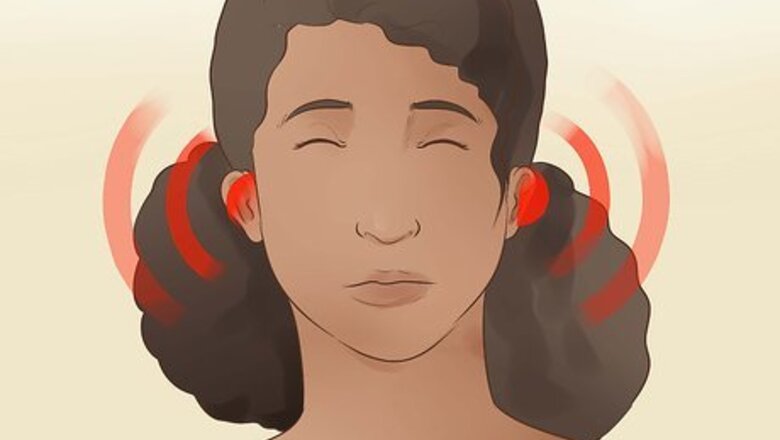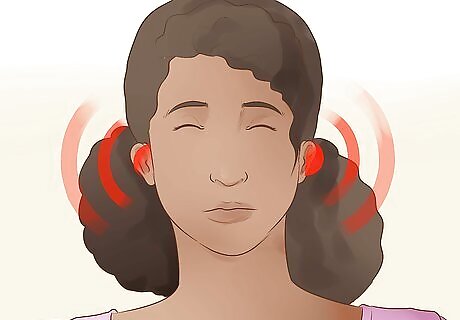
views
Practicing Perceptive Listening

Relax and become aware of what you're hearing. Studies show that talking elevates a person's blood pressure. Listening brings it back down. Listening relaxes us, which allows us to pay attention to our surroundings (and those in it). Perceptive listening goes beyond actively listening, which focuses on listening to another person, reflecting on what he or she says, and sharing your thoughts. It also requires you to think about what the other person is thinking and how he or she acts while talking. It demands focus and being mindful of and present in the conversation by paying close attention to cues from the other person and providing feedback relevant to the discussion.

Remember that listening requires interpretation. The need to interpret information limits people in their ability to understand what a message means. These interpretations are often dictated by a person's life experiences. Therefore, they are also limited by these experiences. This leaves a lot of room for error in understanding what another person means. Instead of trying to process everything at once, break down a complex situation into smaller parts. Go through each piece of information one at a time.

Master perceptive listening. Listening is not an involuntary, automatic response to hearing what someone is saying. It involves a conscious effort on your part and requires practice. Foremost is that you respect the speaker as a human being who deserves to be heard. An effective listener will validate and empower others. This improves the relationship and often leads to future discussions that are straight forward and detailed. Here are some tips to being a more effective listener. Focus your attention, shut out distractions and listen closely to what's said. You cannot assess a statement's logic or the speaker's true intentions if you're unfocused. Respond to what's said so the speaker feels heard and believes you understand what he or she is saying. This feedback also allows you to clear up any misinterpretations in your processing. Don't interrupt when providing feedback. Wait for natural breaks in the conversation and for cues from the speaker, such as “Does that make sense?” Ask questions at appropriate times to draw out what the speaker might not have said otherwise. Pay attention to the speaker's mannerisms and tone, and what they might mean. Consider the context within which the message is delivered and observe what is not said. Meaning is not always openly expressed. For example, if someone is being rude to you at work, they might actually be feeling insecure, unsafe, and invalidated. Don't fill silences simply to avoid them. Give the person time to think through what he or she is thinking and wants to say. Be open-minded to messages that you do not agree with (e.g., prejudicial comments and opposing viewpoints). Allow the speaker to fully explain him or herself. Seek to understand and interpret a message's meaning by using the cues you've been paying attention to and by drawing on your experiences. Make a conscious and active effort to remember what's said. Retaining information is necessary for assessing its relationship to other aspects of the conversation – in the moment. It's also needed to later process the information, which alone can alter your perception and handling of related situations.

Avoid roadblocks that prevent perceptive listening. Try not to ask “why” questions because this can make people feel defensive. Avoid advising the person about what you think should be done unless you're asked. Don't make quick reassurances, such as, “Don't worry about that.” The latter can indicate you're not fully listening or taking the discussion seriously.

Practice perceptive listening in other areas of your life. Listen to the sounds around you and observe how they make you feel. Notice when you aren't noticing sounds and stop, close your eyes, relax and focus. The more you do this, the more you will become aware of the world around you. This will also help you detect odd, unusual and pleasing sounds and become more perceptive about their meanings, in addition to the situations that might accompany them.
Reading Body Language

Learn about body language. Ninety percent of human communication is non-verbal. A person's body language can be voluntary or involuntary, and it is both genetic and learned. It is a strong indicator of how a person feels, but it can vary from one culture to the next. Those discussed in this article are indicators of body language in Western cultures.

Understand the six facial expressions. Psychologists have classified six involuntary facial expressions that they consider to be nearly universal across cultures. They are happiness, sadness, surprise, fear, disgust and anger. Each has its own signals or clues, and can reveal a person's feelings. But remember they are often fleeting, and some people mask them well. Happiness is exhibited by a raising or lowering of the corners of the mouth. Sadness is shown by a lowering of the corners of the mouth and by the raising of the inner portions of one's eyebrows. Surprise can be seen when eyebrows arch, eyes open wide to expose more white area, and when the jaw drops slightly. Fear is revealed through the raising of eyebrows, when eyes open after being shut or narrowed, and when the mouth opens slightly. Disgust is displayed when the upper lip raises, the bridge of the nose wrinkles, and cheeks raise. Anger exhibits itself when eyebrows lower, lips press together firmly, and eyes bulge.

Know what eye movements mean. Many believe that eyes are the windows to the soul. This belief drove many psychological and cognitive researchers to investigate if our involuntary eye movements held meaning. Research has shown our eyes make predictable movements when a person is processing a thought or question. The notion that you can tell if someone is lying based upon the direction of his or her eye movement, however, is a myth. Here's what we do know. Eye movements in any direction increase when a person is recalling information. Our eye movements stop when something interests us. We also avert our gaze when thinking through something, such as the answer to a question. And our eyes stop moving when we're trying to shut out distractions and focus. Eyes move from left to right (or vice versa) when we are either problem-solving or processing and recalling information. And the harder the problem the more your eyes move. Eyes blink at a normal rate of 6-8 times per minute. When a person is under stress, that number rises dramatically. Raised eyebrows not only show fear but also genuine interest in a topic. Furrowed eyebrows signal confusion.

Look at the way a person's mouth moves. Researchers say the mouth's movements reveal a great deal about how a person feels. Pursing your lips, for example, is a sign of anger. Happiness, as discussed, is displayed when the corners of the mouth curve up. However, researchers have found that different smiles mean different things. Natural, spontaneous smiles appear gradually, last briefly and are shown repetitively. Genuine delight is expressed by a series of short smile “bursts” and creases that form at the corners of the eyes. Fake smiles are about 10 times larger than natural, spontaneous ones. They also appear suddenly, last longer than a natural smile, and disappear abruptly.

Observe head movements. A person tilts his or her head when actively listening to a topic that interests him or her. Nodding your head indicates you are interested in the topic and want the other person to continue talking. And rubbing one's forehead or earlobes indicates a person feels uneasy, nervous or vulnerable.

Watch hand and arm movements. People move their hands and arms more than normal when they are speaking or answering a question. They also touch both things and other people more when they respond to intimate questions or when they are physically close to others. Hiding your hands, like in your pockets or behind your back, can indicate deceit. Crossing your arms doesn't always indicate anger, but it can be a defensive posture. It can also mean you feel uneasy with the other person.

Notice body posture and movements. Learning toward another person is a relaxed and interested indicator. Friendly feelings exist. Leaning in too close, on the other hand, can be experienced as a hostile or dominating gesture. Angling yourself toward another person while you're both standing signals respect. It's also often a sign of deference. Adopting postures similar to others tends to increase group or interpersonal rapport. It tells others you are open to their thoughts. Standing with your legs wide apart is either a traditional stance for those in positions of power or a dominating position. A slumped posture indicates boredom, alienation or feeling ashamed. An upright posture asserts confidence, but it also can exude hostility or a sense of uprightness.
Trusting Your Intuition

Understand intuition and its role in your life. Most people have, at some point, experienced a “gut feeling.” It seems to arise from nowhere but is quite distinct. Gut feelings make people feel in any number of ways. They can also cause a person to sense and know things without any logical explanation. And, at times, they spur a person to do things he or she might not otherwise. The famous psychotherapist, Carl Jung, said that all people use intuition as one of the four ways we function in life. The other three are feeling, thinking and sensing. This makes intuition distinct and not determined by the others. Even though many people dismiss intuition as being either nonsense or luck, scientists are now saying it's a very real ability that's been identified in lab settings and on bran scans.

Discover traits of the intuitive person. Researchers say that everyone is born with intuition, but not everyone is open to believing in it or willing to listen to it. And some people are more intuitive than others. That may be because they were naturally born with a heightened awareness. It could be because they've seen it work in their lives. And it might be because, along the way, they learned to notice and pick up on subtle cues from others and the environment. Often those who are very intuitive are also particularly people-focused. They are more easily able to sense what others are feeling. They're generally more emotionally oriented than analytical. They frequently make decisions quickly and efficiently. They're able to do this because they use past experiences and emotions to guide them. Women are often more intuitive than men. This could be the result of an evolutionary process that's made women particularly conscious of human responses and social stimuli. And there is evidence that some people can go a step beyond what's even normal in this realm. There's documentation of people knowing events have occurred far away, even though they have no prior knowledge of the event or factual basis to explain how they knew.

Recognize some of the signs. Scientific studies have shown that highly intuitive people experience changes in their heart rate and get sweaty palms when they are exposed to deceit. They believe it is a response to the stress of subconsciously knowing or suspecting they were being tricked. This seems to indicate that our instincts kick in and cause physical sensations first. Our minds catch up quickly, but second.

Learn to become more intuitive. Though intuition varies, there are things you can do to become more intuitive if you practice and have an open mind. The most basic way is to still (calm) your mind so you can a) listen to your inner voice and b) learn to be more observant of your environment and the people in it. Pay attention to sensations that seem to come out of the blue and have no logical explanation. Our brain's amygdala, which generates the fight-or-flight instinct, is able to activate, process and respond to cues and information before we are consciously aware they exist. It can also process images (and initiate our response to them) that pass before our eyes so fast that we cannot even see them. Researchers believe this stems from our very ancient ancestors' need to quickly gather and assess information if they wanted to survive. Get plenty of REM sleep. During REM, our brains problem solve, connect pieces of information and are most in tune with emotions. Before you go to sleep, write down a problem or worry you have. Think about it for a bit, and then let your brain come up with an intuitive solution during REM. Distract your conscious mind so your intuitive mind has a chance to do its work. Research shows that our intuitive mind processes information even when we're not consciously paying attention to that information. In fact, the decisions a person makes when distracted have been shown to often be the correct ones. If you have a problem or concern, think through your options. Then stop and concentrate on something else. Go with the first solution that comes to you.

Check your gut decisions against the facts. Growing scientific evidence supports the wisdom of many intuitive decisions. Issues such as extreme distress can distort that intuitive processing, though, and lead to bad decision-making. Gut reactions and hunches are not always accurate. A smart approach is to listen to your gut and, at the same time, evaluate what it's telling you against the evidence. Also factor in your emotions. Were they extreme when you got the gut feeling?
Practicing Meditation

Meditate to improve perception. Buddhists have been practicing meditation for more than 2,500 years. Now roughly 10% of Americans meditate as well. Several studies have been conducted showing that meditation can significantly improve perception. Participants in one study were able to detect small visual variations. They had abnormally long attention spans as well. Another demonstrated that the regions in the brain associated with a) sensitivity to body signals and b) sensory processing have increased grey matter when a person regularly meditates. Grey matter is a type of tissue in the Central Nervous System that processes information and triggers a sensory response to it. It is believed that meditating creates more neural connections in the prefrontal cortex of the brain. This region processes sensory information, handles rational decision-making and regulates the amygdala. Teaching yourself to relax, to tune things out, and to be receptive – rather than reactive – to the moment enhances your ability to receive cues around you.

Learn about the types of meditation. Meditation is an umbrella term for the ways you can achieve a relaxed state of being. Different types of meditation have different meditative processes. Here are some of the most widely practiced types of meditation. Guided meditation is led by a teacher, therapist or guide who talks you through visualizing images of people, places, things and experiences that you find relaxing. Mantra meditation involves repeating a calming word, thought or phrase to prevent distracting thoughts from entering your mind. Mindfulness meditation asks that you focus on the present moment and your breathing. Observe your thoughts and emotions without judging them harshly. Qi gong combines meditation, physical movement, breathing exercises and relaxation to restore balance in your thinking. Tai chi is a form of the Chinese martial arts, but movements and postures are slow. You need to also focus on deep breathing. Transcendental meditation involves silently repeating a personal mantra – a word, sound or phrase – to get your body into a state of deep relaxation. Here your mind can strive for inner peace. Yoga is the practice of performing a series of postures and breathing exercises to create a more flexible body and a calm mind. Going from one pose to another requires concentration and balance. Therefore, the emphasis is on thinking only of the present moment.

Discover ways to practice it daily. You can practice meditation on your own at any point in the day. You don't need a formal class. The length of time you meditate is not as important as doing it regularly, and to the point of relaxation. Breathe deeply and slowly through your nose. Concentrate on feeling and listening as you inhale and exhale. When your mind wanders, focus back on your breathing. Scan your body and become aware of any sensations you feel. Focus your attention on different parts of your body. Combine this with breathing exercises to relax each part of your body. Create your own mantra and repeat it throughout the day. Walk slowly, anywhere, and focus on the movement of your legs and feet. Repeat action words in your mind, such as “lifting” or “moving," as you place one foot in front of another. Pray in spoken or written form using your own words or those written by others. Read poetry or books that are sacred to you, and then reflect on the meaning of what you read. You can also listen to music or spoken words that are inspiring or relaxing. Afterward, write down your reflections or discuss them with another, if you choose. Focus on a sacred object or being and think loving, compassionate and grateful thoughts. You can also close your eyes and visualize the object or being.














Comments
0 comment